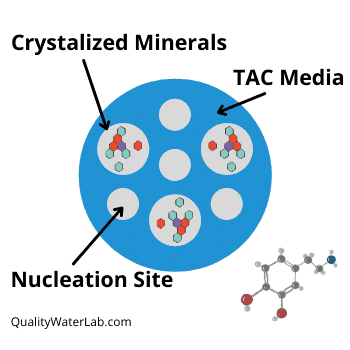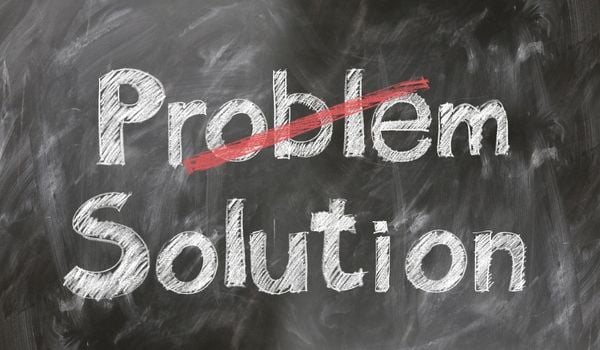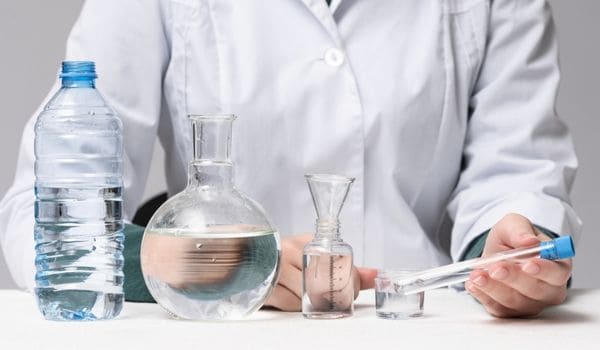Salt-based softeners have their place — but let’s be honest, they’re not for everyone. Between the salt bags, wastewater, and maintenance, it’s easy to see why folks look for alternatives.
That’s where Template Assisted Crystallization (TAC) steps in. It doesn’t “soften” water in the traditional sense, but it does prevent scale — and that’s the real villain behind clogs, stains, and shortened appliance life.
So… does TAC actually work? Let’s break it down.
⚡ Quick Takeaway
- 🧪 What it is: A salt-free conditioning method that changes hard minerals into harmless crystals
- 🚿 What it helps: Prevents scale buildup in pipes, heaters, and appliances
- 🌱 Why people like it: No salt, no electricity, no waste — and minimal maintenance
- 📉 Limitations: Won’t fix all the effects of hard water (like dry skin or spots on dishes)
- 💧 Best for: Homes with moderate hardness, especially on wells or in eco-sensitive areas
🧬 What Is TAC and How Does It Work?

TAC systems offer a low-maintenance way to handle scale — without relying on salt, electricity, or wastewater discharge.
Instead of removing minerals like calcium and magnesium, TAC changes the way they behave. Inside each unit, small ceramic beads act as nucleation sites — triggering those minerals to form tiny crystals.

💡 Here’s what makes it work:
The crystals stay suspended in the water — not stuck to your pipes or heating elements. That means less crusty buildup on fixtures, fewer hot water heater issues, and a break from scrubbing scale rings off your faucet heads.
TAC is efficient, eco-friendly, and easy to install — especially if you want whole-house scale protection without the mess or added cost of a traditional softener.
📌 Bottom line:
You still get the perks of scale control — just without the salt, slime, or sky-high maintenance.
🔬 Does TAC Actually Work Against Scale?

If you’re wondering whether TAC is all talk — good news: the science backs it up.
Arizona State University ran one of the most detailed studies comparing salt-free water conditioners, and TAC stood out by a wide margin. It reduced scale buildup by over 90%, outperforming other systems without relying on salt, electricity, or chemicals. You can check out the study here.
📊 Here’s how different systems stacked up in their lab tests (measured by grams of calcium carbonate buildup):
| System Type | 80°C | 60°C | CAP Water | Scottsdale Water |
|---|---|---|---|---|
| 🚫 No Treatment | 13.36g | 9.97g | 20.00g | 29.75g |
| ✅ TAC Conditioner | 0.48g | 0.33g | 0.65g | 3.20g |
| ⚡ EIP (Electric) | 6.72g | 5.56g | 9.84g | 15.40g |
| 🧲 Magnetic System | 7.56g | 5.28g | 10.23g | 16.70g |
🔍 What This Means:
Even under high-heat conditions — where scale tends to form fastest — TAC showed major reductions in buildup compared to other salt-free options. That means fewer headaches, better appliance performance, and cleaner pipes.
⚖️ TAC or Salt-Based? Here’s How They Compare
If you’ve been weighing the pros and cons between salt-free conditioners like TAC and traditional salt-based softeners, here’s the breakdown without the marketing fluff.
They don’t do exactly the same thing — but they both aim to solve the same problem: hard water wrecking your plumbing, appliances, and patience.
Let’s take a look at where TAC shines, and where it still plays second fiddle:
| 👍 TAC Benefits | 🛠️ What to Know |
|---|---|
| 🌀 Stops new scale TAC turns calcium into crystals that don’t stick to pipes or fixtures. |
💧 Doesn’t fully “soften” It conditions the water, but minerals are still present — just less destructive. |
| 🔁 Removes existing scale Over time, it can help clear out some of the buildup already inside your pipes. |
📉 Not great for extreme hardness For water over 25 grains per gallon, a traditional softener might be a better fit. |
| 💰 No salt or chemicals No brine tanks, no monthly bags of salt — and no backwash waste. |
🌫️ Doesn’t handle iron If your water has iron, you’ll need a pre-filter to protect the media bed. |
| 🔌 No electricity required No power supply, no drain line — just a media tank plumbed into your main line. |
🛁 Fewer “soft” perks You’ll still see some spots on glass and won’t get that slippery soap feel. |
| 🌍 Eco-friendly No salt discharge, no wastewater — great for drought-prone areas. |
🧼 No chlorine removal Unlike softeners with carbon pre-filters, TAC doesn’t reduce disinfectants. |
🧠 Bottom line?
If your biggest concern is scale — not soft-feeling water or skin-deep perks — TAC is a low-maintenance, eco-friendly alternative that’s surprisingly effective.
💸 Is TAC a Smart Long-Term Investment?

Tired of pouring money into salt, repairs, and high energy bills? TAC might be the budget-friendly fix you’ve been looking for.
Let’s break it down:
🧱 Hard water scale doesn’t just look bad — it wrecks your plumbing and drives up your energy costs. According to research from Arizona State University, even a thin layer of scale can hike your water heater’s energy usage by 20% or more.
And the domino effect?
• Appliances wear out faster
• Water heaters lose efficiency
• Plumbing problems pile up — literally and financially
💡 Where TAC wins: It turns those stubborn scale-forming minerals into harmless crystals before they can stick — keeping your system clean, efficient, and far easier to manage than traditional softeners.
💰 What You’ll Spend (and Save)
| 💡 Cost Factor | Details |
|---|---|
| 🛠️ System Price | Most residential TAC units start around $400 — larger systems with bonus features can climb higher, but they’re still competitive. |
| ♻️ Media Replacement | Expect to spend $100–$150 to replace the media every 5–15 years, depending on your tank size. |
| 🚫 No Ongoing Costs | No salt. No electricity. No wastewater. Just install and go. |
📌 Bottom line: TAC systems aren’t just low-maintenance — they’re low-cost over the long haul. Skip the salt runs, forget the drain line, and enjoy a cleaner system that’s easier on your wallet.
🧂 No Salt. No Chemicals. No Hassle.

One of the best things about TAC systems? They don’t need salt, chemicals, or any of that old-school softener fuss.
Instead of swapping minerals with sodium like traditional softeners, TAC neutralizes them using a physical process — no brine tanks, no recharging cycles.
Here’s what that means for you:
- ✅ No hauling salt bags
- ✅ No brine draining into your yard or septic
- ✅ No added chemicals or phosphates
💸 Bonus: Households that switch to TAC often save ~$400 a year on salt alone — not to mention the time you’ll get back from skipping maintenance chores.
🛠️ And since there’s no electricity or wastewater involved, installation is refreshingly simple. You’ll find plenty of low-maintenance options in our salt-free softener reviews — all tested with real-life practicality in mind.
♻️ Eco-Friendly & Sustainable
If you’re trying to cut down your home’s environmental impact, TAC is a no-brainer.
Unlike salt-based systems that discharge salty brine into wastewater systems (often banned in eco-sensitive areas), TAC systems:
- 🌱 Don’t pollute – No brine discharge, no phosphates, no added chemicals.
- 🌎 Work anywhere – Safe for septic systems and allowed where traditional softeners are restricted.
- 🧼 Reduce plastic waste – Fewer bags, fewer chemicals, and minimal replacement parts.
💡 Bonus: No backflushing also means you’re not dumping treated water down the drain every week — just clean water, doing its job efficiently.
🥗 Does TAC Water Taste Better or Improve Health?

Traditional softeners remove calcium and magnesium — two essential minerals — and replace them with sodium. That can give water a slightly salty flavor and may not be ideal for people watching their sodium intake, plants, or pets.
TAC systems, on the other hand, don’t add or remove anything — they simply change the structure of hardness minerals so they stop causing scale. You keep the good stuff, skip the salt, and your water tastes like… well, water.
⚠️ What TAC Doesn’t Do
Template-based systems are impressive — but they’re not miracle workers. Like anything, there are a few trade-offs.
Here’s what to keep in mind if you’re considering a TAC system:
| ⚠️ Limitation | What to Know |
|---|---|
| Not for very hard water | TAC works best up to 25 grains per gallon. If your water is harder than that, a traditional softener may still be the better bet. |
| Doesn’t remove iron | You’ll need a prefilter if your water has iron. Otherwise, it can clog or damage the TAC media over time. |
| Minor spotting possible | Soft scale may still show up on glassware or fixtures — but it wipes away easily and doesn’t build up. |
| No “slippery” feel | Because TAC doesn’t remove minerals, the water won’t feel slick like salt-softened water. Some people prefer it! |
💡 Bottom line: TAC gives you a low-maintenance, eco-friendly way to fight scale — but if you’re dealing with very high hardness or iron, you may want to test your water and consider a combo system.
💧 Test Before You Invest

Before installing a TAC system, it’s smart to test your water — especially if you’re unsure how hard it really is or suspect other issues like iron.
💧 Why it matters:
- TAC is most effective for water under 25 grains per gallon hardness.
- It doesn’t remove iron — so if that’s in your water, a prefilter may be needed.
- City water? A carbon prefilter can help extend the life of your TAC media by removing chlorine.
🧪 Your testing options:
- DIY test strips for a quick snapshot
- Lab kits like Tap Score for a full breakdown + filter recommendations
📌 Pro Tip: Even crystal-clear water can contain hidden minerals and metals. Testing now helps avoid surprise issues later.
🧰 Are TAC Systems Easy to Install?
Yes — and that’s one of the biggest perks.
Unlike traditional softeners, TAC units don’t need electricity or a drain, which makes installation simpler and often DIY-friendly.
🧵 Here’s how it works:
- A single tank connects directly to your main water line
- No brine tank to mess with
- No wiring or power source required
- No wastewater to manage
💡 Pro tip: If you’re comfortable with basic plumbing and have room near your water main, you can likely install it yourself — or save big on labor if hiring a plumber.
♻️ Are There Other Salt-Free Alternatives?
Yes — but they’re not all created equal.
While TAC leads the pack in effectiveness, there are a few other salt-free systems on the market. Here’s how they stack up:
| Technology | How It Works | Effectiveness |
|---|---|---|
| ⚡ TAC (Template Assisted Crystallization) | Crystallizes hard minerals so they can’t stick to pipes or appliances | Up to 90%+ scale prevention |
| 🔌 Capacitive Deionization (CDI) | Uses electrical charges to remove ions from water | Effective, but expensive and less common in homes |
| 🧲 Magnetic Descalers | Claims to alter mineral behavior using magnets | Mixed results — limited peer-reviewed data |
| ⚗️ Electrically Induced Precipitation (EIP) | Triggers minerals to solidify before entering plumbing | Moderate performance, less practical for home use |
📌 Bottom line: While plenty of salt-free technologies sound promising on paper, few have the track record or practical reliability that TAC systems offer. They’re simple, low-maintenance, and actually do what most homeowners are hoping for — protect appliances without the salt, waste, or fuss.
💭 Final Thoughts
If hard water is giving your plumbing a hard time but you’re not thrilled about lugging around salt bags or dealing with brine discharge — TAC might be your water system’s new best friend.
It doesn’t soften water in the traditional sense, but it does something arguably better for many households: it keeps scale from building up, without the side effects of salt-based systems.
- 👍 Easy to install
- 💸 Low maintenance
- 🌎 Eco-friendly
- 🧂 And no salt required
It’s not a one-size-fits-all solution — but for moderate hardness and scale prevention, it checks a lot of boxes. Just be sure to test your water first, and pair it with the right setup to get the most out of it.
 136 people found this helpful. Was this guide helpful to you?
136 people found this helpful. Was this guide helpful to you? 

